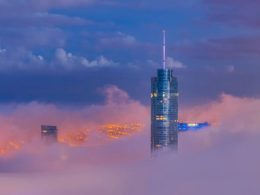by Trader Mark, Fund My Mutual Fund
While I read this piece in the Wall Street Journal, I was struck by the parallels you see in the U.S. - of course, it goes without saying being poor here is a very different thing than being poor in India or any emerging or developing country. But the distinction between who is benefiting and who is not in the economy, [Oct 22, 2010: Reuters Special Report - The Haves, the Have Nots, and the Dreamless Dead] along with political dysfunction, corruption, empty promises, and the like sounds so very familiar. Little known fact - after the U.S. the country with the most billionaires at Davos was India.
I would assume at some point in the future, to make sure the hundreds of millions at the bottom don't start an uprising, the Indian government will follow the American policy of circus and bread to keep the lower tranches of society occupied and fed. A very good read for those who are investing in India to understand the backdrop.
- India's economy is going great guns. Among the world's major nations, its growth is second only to China's. Yet in recent months, the mood in the planet's most-populous democracy has soured badly—to the point where even some of India's richest people have begun to complain that things are seriously amiss.
- No one is disputing that the boom has created huge wealth for the business elite and much better lives for hundreds of millions of people. But the benefits of growth still haven't spread widely among India's 1.2 billion residents. And a string of corruption scandals has exposed an embarrassing lack of effective governance. (after the first few sentences, I thought the story was about the U.S.)
- This wasn't supposed to be the picture 20 years after India abandoned its Soviet-style, centrally planned economic model, embraced capitalism and jump-started economic growth. Historic reforms begun in 1991 held out the promise of transforming the country from an agrarian backwater into an industrial powerhouse, lifting almost everyone's standard of living in the process.
- India enjoyed years of heady growth, despite problems its East Asian peers didn't share, such as its deep caste divisions. Now, though, a host of problems has stalled the transformation. The public-education system is a shambles. No significant publicly owned businesses have been privatized in years. The promised modernization of the financial system has happened only in fits and starts. Land reform needed to stimulate industrialization has been a political nonstarter. And malnutrition remains widespread.
- Ravi Venkatesan, until this week chairman of Microsoft Corp.'s India arm, says his nation is at a crossroads. "We could end up with a rather unstable society, as aspirations are increasing and those left behind are no longer content to live out their lives. You already see anger and expressions of it," he says. "I strongly have a sense we're at a tipping point: There is incredible opportunity but also dark forces. What we do as an elite and as a country in the next couple of years will be very decisive."
- India's economic liberalization was kicked off by a financial crisis in 1991, when the nation was on the verge of defaulting on its debt. Manmohan Singh, the nation's current prime minister, was finance minister at the time. The initiatives he introduced staved off financial collapse. Economic growth, which had fallen to about 1% in 1991, quickly picked up.
- In many important respects, the changes turned this nation into a success story. Life expectancy rose to 64 years in 2008, from 58 in 1991. Literacy has risen. Hundreds of millions have seen their incomes improve. Per capita gross domestic product increased to $3,270 in 2009, from $925 in 1991, according to the World Bank.
- Other important gauges of national well-being paint a more troubling picture. "What has globalization and industrialization done for India?" asks Mr. Venkatesan, Microsoft's former India chairman. "About 400 million people have seen benefits, and 800 million haven't."
- Calorie consumption by the bottom 50% of the population has been declining since 1987, according to the 2009-10 economic survey conducted by India's Ministry of Finance, even as those at the top of society struggle with rising obesity. (seems like an ideal time for a food stamp program to keep the poor from getting unruly)
- Infrastructure in cities and the countryside remains woefully inadequate: In recent years, China has added, on average, more than 10 times as much power as India to its electricity grid each year.
- Data from McKinsey & Co. show that the number of households in the highest-earning income bracket, making more than $34,000 a year, has risen to 2.5 million, from 1 million in 2005. But the ranks of those at the bottom, making less than $3,000 a year, also have grown, to 111 million, from 101 million in 2005.
- But among the most visible signs of India's modernization is an entrenched consumerist creed. Sales of luxury goods are booming. Mansions are replacing one-story homes in middle-class neighborhoods. Upscale malls are sprouting up around the country.
- Many of the urban poor, in contrast, are slipping backward because of rising prices—a persistent and destructive accompaniment to India's high growth rate. Food inflation today is running at about 10%, and general inflation in excess of 8%.
- Politics are partly to blame for stalling the liberalization drive. The Congress party, which has ruled the nation for most of the 64 years since India gained independence from Great Britain, depends on smaller regional parties to maintain its governing coalition in parliament. That makes policy formulation risk-averse, since small allies hold the power to break ranks and sink the coalition.
- Frustration over the economic miracle's limited trickle-down is fueling political movements around the country. Most base their appeal, in part, on the idea that the poor are being ill-served in the new India.
- But corruption is considered more prevalent now than ever before, because economic expansion has created more opportunities for graft—for example, in the granting and funding of infrastructure projects.
- The amount of business activity that evades direct taxes has soared, says Arun Kumar, chairman of the Center for Economic Studies and Planning at Jawaharlal Nehru University in New Delhi and a specialist on the "black economy." A landmark study in the mid-1950s, he says, estimated that the black economy accounted for 4% to 5% of India's gross domestic product. Rather than declining, he says, the black economy has become systemic. He estimates it reached 40% of GDP by 1996, and 50% by 2006. (that is simply astounding) "The reason it has grown is that illegality in society has become more and more tolerable," he says.
- India's modernization was expected to prompt a mass movement of workers from farms to factory floors—a critical component in the transformation of China, South Korea and other Asian nations. But manufacturing as a share of India's economy stood at 16% in 2009, the same as in 1991, according to the World Bank.
- Services have increased dramatically as a proportion of gross domestic product, rising to 55% in 2009, from 45% in 1991, according to the World Bank, becoming the chief engine of India's economic strength. But many of the fastest-growing areas, such as finance and technology, employ relatively few and rely heavily on skilled employees. The entire software and technology-services sector, including call centers and outsourcing, directly employs just 2.5 million workers, a tiny fraction of the overall work force.
- Agriculture's share of the economy, meanwhile, has declined to about 17% in 2009, from 30% in 1991. But the number of people working in agriculture hasn't dropped commensurately, according to Arvind Panagariya, a professor of Indian political economy at Columbia University in New York. "The dependence on agriculture remains incredibly high when you compare India's high-growth phase with others," he says. "The potential of the country is to grow at 11% to 12%, and it's growing only at 8% to 9%."











